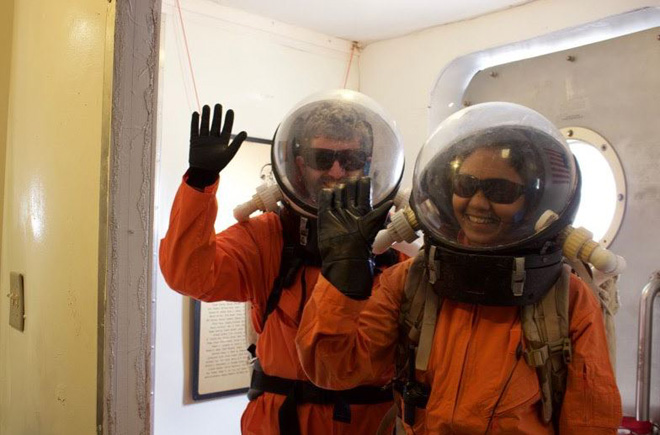
Courtesy: The Mars Society
Biologist Anushree Srivastava jetted off on a ‘mission to Mars’ immediately after completing her MSc at the School of Biological Sciences at the University of Essex.
Originally from Lucknow in India, Anushree has just found out she gained a distinction for her Biotechnology Masters at Essex while in the middle of the Utah desert taking part in the pioneering Mars 160 Twin Desert-Arctic Analog simulation mission.
The mission - involving an eight-strong crew - started in September and is being spearheaded by the Mars Society, the world's largest and most influential space advocacy organisation dedicated to the human exploration and settlement of the planet Mars.
The project is simulating what a mission to Mars would really be like and as a crew biologist Anushree’s work will help explore Mars 'analogs' - environments with strong similarities with a Martian environment - from a ‘geomicrobiological’ perspective.
From Essex to Mars

Courtesy: The Mars Society
Anushree's studies at Essex have helped her develop the skills needed to investigate the diversity of microbial life in the extreme, high-salt – halophilic – environments you find in the sites the Mars 160 mission team is visiting.
She said: “My principal research interests lie in the field of geomicrobiology, but I have a real interdisciplinary interest in astrobiology and space exploration.To pursue this combination of interests, I joined the Masters program in biotechnology at the University of Essex.
“Under the supervision of Dr Terry McGenity, I studied Messinian halite salt deposits from an astromicrobiological and biogeographical perspective.”
The Mars 160 mission consists of two 80 day fieldwork sessions: the first session is being conducted in the Utah desert at the Mars Desert Research Station (MDRS) and the second mission is in the Flashline Mars Analog Research Station (FMARS) in the Canadian Arctic.
“This is an ambitious and long-term simulated Mars mission and,” said Anushree. “As a crew biologist I am working on three principal projects which have significant astrobiological implications.
“Astrobiology addresses the most profound question of humankind – ‘Are we alone?’ Astrobiology explores the possibility of finding extinct or extant life elsewhere in the universe, as well as investigating the origin and evolution of life on Earth.
“One of the principal targets of the Mars 160 science goals is to explore the extreme niches of the two significant Mars analogs: the Utah Desert and the Canadian Arctic for 160 days, and studying the extremophile diversity.
“Personally, I am interested in finding the microbial life in ancient evaporite deposits of these Mars analogs. And our study during the Mars 160 mission will help us understand the potential of finding life in the similar environment of Mars.”
“I intend to conduct a microbiological analysis of salt crystals. Any sign of life detected in those deposits and the characterization of microbial communities will aid in understanding the nature of possible microbial ecology on Mars.”
A love for astrobiology and space

Courtesy: The Mars Society
Anushree earned a Bachelors of Arts in Ancient Indian History and Anthropology and Master of Arts in Anthropology from Lucknow University which allowed her to develop her expertise in biological anthropology. However, her growing interest in astrobiology and space exploration, later on, inspired her to apply for a Master of Science program.
She applied to Essex because she was very interested in studying the prolonged survivability of halophiles buried inside ancient halite in the laboratory of Dr McGenity. As part of her MSc research project, she had the opportunity to study the ~6 million years old (Messinian) evaporite deposits and performed microbiological analysis. She feels fortunate to have had the chance to be inspired by the work of Dr McGenity at Essex and Professor Stefano Lugli, from the University of Modena and Reggio Emilia.
Now in the Utah desert she is using the skills she learnt in Essex labs to uncover evidence of life in extreme environments. “This long-term simulation is very important in terms of understanding the ability of humans to conduct science operations on Mars,” said Anushree. “We perform extra-vehicular activities (EVAs) in the heavy space suits and conduct scientific operations on the field which is physically demanding. Inside the habitat, we perform different human factors research which is highly relevant for studying humans in the simulated environments and how it can influence the future human colonization of Mars.
“I perform the astrobiological research here at Mars Desert Research Station as the ‘Mars-based’ astronaut-scientist in cooperation with ‘Earth-based’ experts based at NASA’s Ames Research Centre and the Canadian Museum of Science, through asynchronous communication. During this simulation, we are also testing how this communication works between “Mars” and “Earth” based teams which is how it is supposed to be in the real Mars mission.”
Her love of space has already led to Anushree getting involved in other space simulations. She recently visited Leh, Ladakh, Jammu and Kashmir in India, as part of the NASA Spaceward Bound India 2016 expedition team. As the part of the science team, she was responsible for collecting the sample of evaporite deposits at TsoKar which is an ancient lake and again considered to have many similarities to the evaporite deposits on the surface of Mars.
So what of the future? “I hope to become part of a Doctoral program after finishing the Mars160 simulation to carry forward my passion for astrobiology,” said Anushree. “And in turn, contributing towards the future astrobiological exploration of Mars!”
Links
Mars Society project site